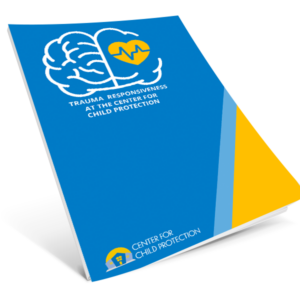Trauma Responsive Hub
Making Austin a trauma-informed community.


Trauma Responsive = 3 R’s
What if just one instance of physical or sexual child abuse could set off a chain reaction of biological and social changes that dramatically change the course of a child’s life? The Center for Child Protection supports “Trauma Responsiveness” as an ideal, research-driven way for EVERYONE to interact with ANY CHILD they suspect may have suffered trauma.
The three principles below can make a profound difference in limiting the amount of damage abuse can inflict on a child’s brain.
1. Realize
What Can Lead to Child Trauma
Children and adolescents experience a wide range of events during childhood – abuse, neglect, violence, drugs – that create toxic, trauma-inducing environments.
of kids have substance abusing relatives and/or caregivers
children grew up in or around a home with violence
couples commit physical or emotional violence

Meet Mikaela
A bright child with lots of energy, Mikaela wants to be a teacher when she grows up.
What we need to know…
- She lives with her grandparents because her father is in prison
- Her mother aged out of CPS care at age 18
- Her mother and grandmother have a history of abuse and neglect
- She’s only seen her mother once
Being Trauma Responsive
Sometimes we just can’t see all the ways a child may be shaped by trauma.
Part of bring trauma responsive is to never assume we are fully aware of a child’s history and/or life experiences. With so many children facing so many unfortunate circumstances, unusual behavior may be the result of a prior traumatic experience.
Does trauma create risky behavior? YES
The research is clear – the more traumatic experiences children undergo, the more likely they will engage in risky behaviors and have serious health issues. If a child exhibits unusual or bad behavior, what might we learn if we look at them through the lens of “What happened to you?” instead of “What’s wrong with you?”
2. Recognize
The Fragile Child’s Brain
To really understand child trauma it’s important to look more closely at a child’s brain development.
Responsible for problem solving, decision making, impulse control and processing complex information
Regulates emotions and capacity for relationships
Controls survival and critical body regulation (blood pressure, heart rate, temperature)
Relays sensory signals within the brain while also contolling sleep and alertness

What Does This Mean?
The brain develops from the bottom to the top. Trauma symptoms are often held in the brainstem where a child is in fight, flight or freeze. This impairs critical thinking and the ability to form relationships.
But, relationships and healthy connections matter. If you are consistent, predictable and nurturing, children perceive a safe world full of hope and support.


1-800-252-5400 www.TxAbuseHotline.org
If you suspect a child is being abused or neglected, you must report it. If it is an emergency, dial 9-1-1.
3. Respond
Being Trauma Responsive
Here is a short video with a few different ways that thoughtful responses to trauma can be conducive to healing abused children.
Are Your Actions Trauma Responsive?
Are you aware of the cycles of emotion or survival mechanisms like fight, flight, freeze or being submissive? Being aware of this is helpful when trying to get a child to a calmer state.
Are you able to respond by being culturally aware? Are you in a place where you can create long-lasting support? Are you ready to instill hope and resilience?

Trauma Responsiveness at the Center
To read more about our trauma response and how to become trauma responsive, download our Trauma Booklet here or visit our Education Services page to start your journey to learning more about this issue.
The Center for Child Protection is the very first children’s advocacy center in the United States to become site certified in the Neurosequential Model developed by world renowned trauma expert Dr. Bruce Perry and the Child Trauma Academy.
NMT uses the principles of neurobiology to guide assessment and treatment planning for children whose development has been disrupted by trauma. The Center uses these principles as a foundation for all its clinical and trauma responsiveness with child abuse victims and their protective caregivers.




